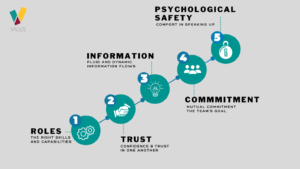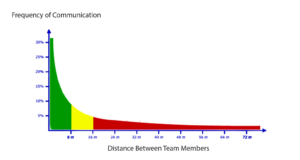How's your teaming going?
Aug 29, 2022The traditional model of how teams progress goes by stages – forming, storming, norming and performing. While it’s easy to remember, teams today don’t necessarily follow that model. They’re dispersed, virtual, temporary and potentially remote. So how do you know if things are going well?

As my friend Jeff Pfeffer says, unless you are a sole contributor, your success depends on other people
An essential element in the success of any creative, innovative effort is to create teams of people who can cover diverse terrain, bring different skills to bear and basically work together. In my own research, I found that “deft” teams were essential to being able to create a new competitive advantage. Even though I was interested in new capability creation, I stumbled across teams. Amy Edmondson and I often joke about this – she studied teams and bumped into strategies, and I studied strategies and bumped into teams!
The result of all this research is a simple, but rich diagnostic that can quickly pinpoint where your team may be struggling. It measures five core characteristics that determine whether a team is likely to produce results – or just frustration.
Roles
Obvious, maybe, but if you don’t have the right people in the right roles, your team will struggle. Why does this so often happen? Basically, from a failure to structure the team in the first place.
We put people who are available on teams. We let people volunteer. We let friend groups decide to do projects together. We stick people on teams when we don’t know what else to do with them. In any case, what often happens is that you have a team with critical skill / capability gaps. This slows everything down.
Trust
A big myth of teamwork is that you must like one another to trust one another. I can think of a whole lot of people who I may not be socially happy hanging out with, but whose work and capabilities I would trust immensely. Trust is born of repeated, predictable interaction. If you do what you say you will and behave in a consistent way, that fosters trust. If you are erratic, unpredictable and unreliable, that undermines trust. It is also critical to trust that your words and actions line up – people are very good at sniffing out hypocrisy and self-dealing.
Information flows
As teams work virtually, one very robust research conclusion is that you have to be much more deliberate about structuring the flows of information than if everyone is physically together. One of the most famous studies was done by MIT’s Thomas Allen, in which he found that if people were physically located more than 60 feet apart, they may as well have been on the other side of the country. His findings were summarized in the very famous “Allen Curve.”

As we come out of the pandemic realizing that an awful lot of work is going to be hybrid or virtual, we need to pay much more attention to the structuring and sharing of information.
Commitment
All the other factors aside, a huge issue with teams has to do with members’ commitment to the team’s success. People aren’t necessarily bad people if they aren’t committed, and that’s important to realize. They may have been stuck on this team without really buying into what it is to do. They may have other priorities. It may not be in their own best interest to see this team succeed while something else doesn’t work out. Whatever the issues with commitment, the sooner you can bring them to the surface and address them, the better.
Psychological safety
This construct, first identified by Amy Edmondson and subsequently immensely popularized, refers to the ability of team members to bring up information without fear of being punished. This could be information about mistakes, about an opinion that differs from the norm or a point of view that isn’t consistent with what powerful people want to hear. The big issue is that if you don’t have psychological safety in your team, incredibly valuable information may never make it into your conversation. Amy’s research has found that a lack of such safety can literally cost lives and create havoc in complex systems.
Diagnosis
With this short explanation behind us, I’m delighted to share that at Valize, we’ve created a free self-service version of the survey we use to do the team assessment. You can access it right on the Valize web site at https://www.valize.com/teameffectivenessfreesurvey. This version lets you self-assess how a team that you’re part of is working.
An even more powerful version of the assessment is when your whole team takes it. With that data, we can identify the most troubling issues and recommend interventions to resolve them. I’ve seen teams completely transform how they operate after taking the survey and debriefing it – not bad for the effort of answering just 20 short questions online! Try it out for yourself, and if it’s something you would like to use for your team, we can administer the survey and provide a debrief. Contact [email protected] to set that up.
Meanwhile, a new cohort of learners is forming
We’re also launching a new cohort of learners for our discovery driven planning / customer insight program. The class will get going the week of September 12 and go through mid-November. I’ll be running six live one-hour sessions during the run, and you’ll have access to videos, downloads, explainers and more. We suggest you try to free demo course and if it appeals to you, come join the cohort. Our first group reported that they got a lot of value out of it (and are even asking impatiently when new courses will be available!)
Free demo course here:

